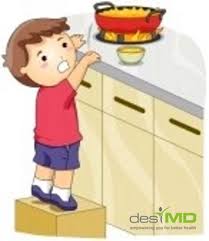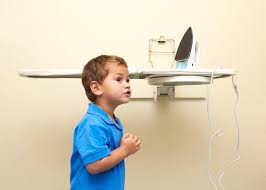The season of festivities is here. There is joy in the air. Navratri, Durga Pooja, Dushehra, and Diwali and Christmas awaited, have added to the excitement and bonhomie of all and children in particular. Add to that, the weather has changed for the better. A delicious chill in the air and flowering of plants have added to the rosy atmosphere. It has meant, increased travel for pleasure ., buying warm clothes, sweetmeats, and hallmark of the festival of lights, firecrackers. All these make mundane lives exciting but also expose our children to risks of injury due to fire, BURNS.
Children are particularly vulnerable to burns. they are the 11th leading cause of death of children aged 1–9 years and are also the fifth most common cause of non-fatal childhood injuries. (WHO)
scalds account for 95% of burns in children less than 5 yrs, whereas fire burns and cracker burns are more common in older children.
Overall 75% of burns in young children are from hot liquid (tea/coffee/daal / Oil ),
hot tap water or hot stored water for the bath, or steam.
Socioeconomic factors also play a role in determining the risk factors for children.
- Low rate of literacy within the family;
- Living in overcrowded dwellings or with cluttered areas in the home;
- Failure to properly supervise children;
- A history of burns among siblings.
- Has a higher risk of sustaining burns.
Mortality and morbidity from burns are strongly associated with poverty, with a higher incidence of burns among children in low-income and middle-income countries and poorer families in high-income countries.
Infants have the highest death rates, while those aged between 10 and 14 years have the lowest. The death rate climbs again for 15–19-year-olds. (UNICEF)
Why are burns more common in children (Especially under 5 yrs of age)?
Children LOVE to imitate adults. They may pretend to cook just like an adult they’ve seen without realizing that hot food or liquids or hot tap water can be dangerous. They are less mobile, and can’t react as quickly as an adult if they come into contact with a hot object or substance. Young children have thinner skin than older children and adults, so they suffer a burn injury at a lower temperature in less time. Spilling a cup of coffee or other hot drink can cover a large part of a small child’s body. This would cause a much larger burn on a small child than it would on an adult.
Scalds:
The 2 most common scald injury patterns, according to Dorothy A. Drago were,
- The child reached up and pulled a pot of hot water/tea/oil off the stove or other elevated surface.
- The child grabbed, overturned, or spilt a container of hot water kept on the floor, onto him- or herself.
- Steam – lifting the lid of the container containing boiling water.
- Hot beverage falls on a child, (mother carrying a tray of teacups), and the child comes running and hugs the mother, spilling the tea on him/herself)
- Adult giving a bath to a child with too hot water. (not very rare)

How to prevent?
- Avoid holding your baby and a hot drink at the same time. A wriggling baby may cause you to spill your drink on them and you.
- Try not to leave hot drinks/food within easy reach. Babies are likely to grab at cups or mugs and spill the contents over themselves.
- Do not leave hot water in a bucket for bath unattended, and bring to safe temperature by mixing, immediately.
- Check the water temperature, before giving a bath.
- When carrying hot water in a utensil, ensure the child cannot surprise you.
Flame Burns: cause
- Heating or cooking on open fires that are at ground level
- Loose and fire catching clothes in vicinity of open flames (Diwali diyas)
- Open fire for warmth and sleep nearby
- Heating devices (pressing iron, hairdryer/straightener, hot water immersion heater) accessible to the child


Electrical Burns:
- Sockets, open wires, and faulty equipment.
- Water coolers, and immersion heaters.
- GOLDEN RULE – NO ACCESS, Supervision.
Cracker burns:
Failure of parents to recognize children’s ability to be near the hazard and failure to recognize the potential severity of the resulting injury is the primary cause of this injury and its resultant mortality and morbidity.
They are entirely preventable.
Preventive Steps:
- Adult supervision at all times
- Open area with access to clear sky
- Follow instructions given on the cracker
Store crackers away from sources of fire keep them away from toddlers - Keep buckets of water and blankets ready, in case a fire breaks out.
- Wear footwear
Warnings:
- Do not try to use failed crackers
- Do not reignite failed crackers
- Do not modify crackers
- Do not bend over crackers while igniting them
First Aid:
Do’s:
- Stop the burning process by removing clothing and washing the burns with cool water.
- Extinguish flames by allowing the patient to roll on the ground, or by applying a blanket, or by using water or other fire-extinguishing liquids.
- Use cool running water to reduce the temperature of the burn.
- In chemical burns, remove or dilute the chemical agent by irrigating with large volumes of water.
- Wrap the patient in a clean cloth or sheet and transport them to the nearest appropriate facility for medical care.
Don’ts:
- Do not start first aid before ensuring your own safety (switch off electrical current, wear gloves for chemicals etc.)
- Do not apply the paste, oil, Haldi (turmeric) or raw cotton to the burn.
- Do not apply ice because it deepens the injury.
- Avoid prolonged cooling with water because it will lead to hypothermia.
- Do not open blisters until topical antimicrobials can be applied, such as by a healthcare provider.
- Do not apply any material directly to the wound as it might become infected.
- Avoid application of topical medication until the patient has been placed under appropriate medical care.
Source – WHO
Children deserve to be HEALTHY, HAPPY AND SAFE. Safety does not happen by accident. It is the result of collective consensus and public investment. As the Nobel laureate, Mr Nelson Mandela has said, “ We owe our children, the most vulnerable citizens of our society, a healthy life free of trauma, violence and fear.”
Let us all make this Diwali safe for our children!
– Dr. Jitendra Hazare

